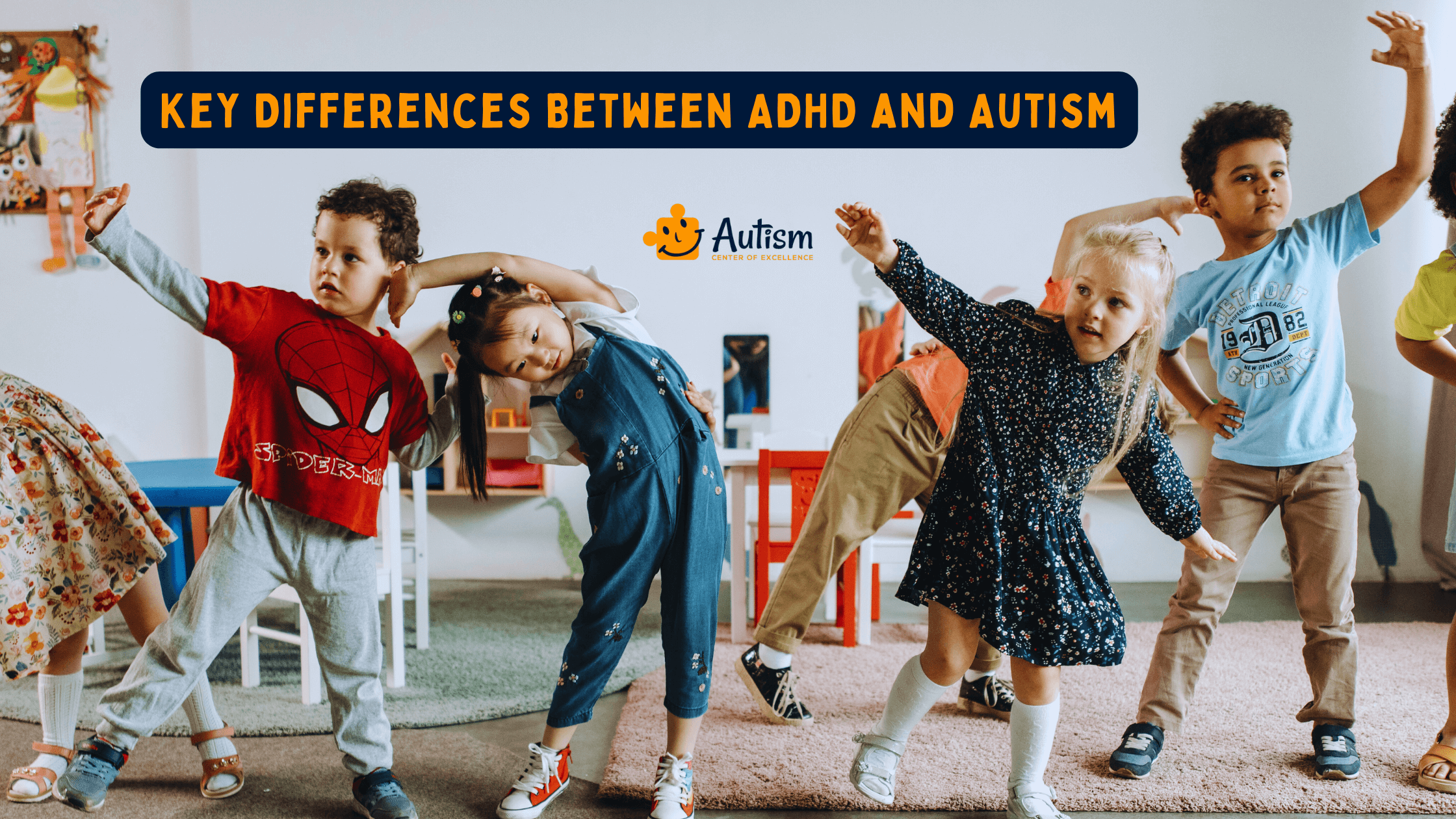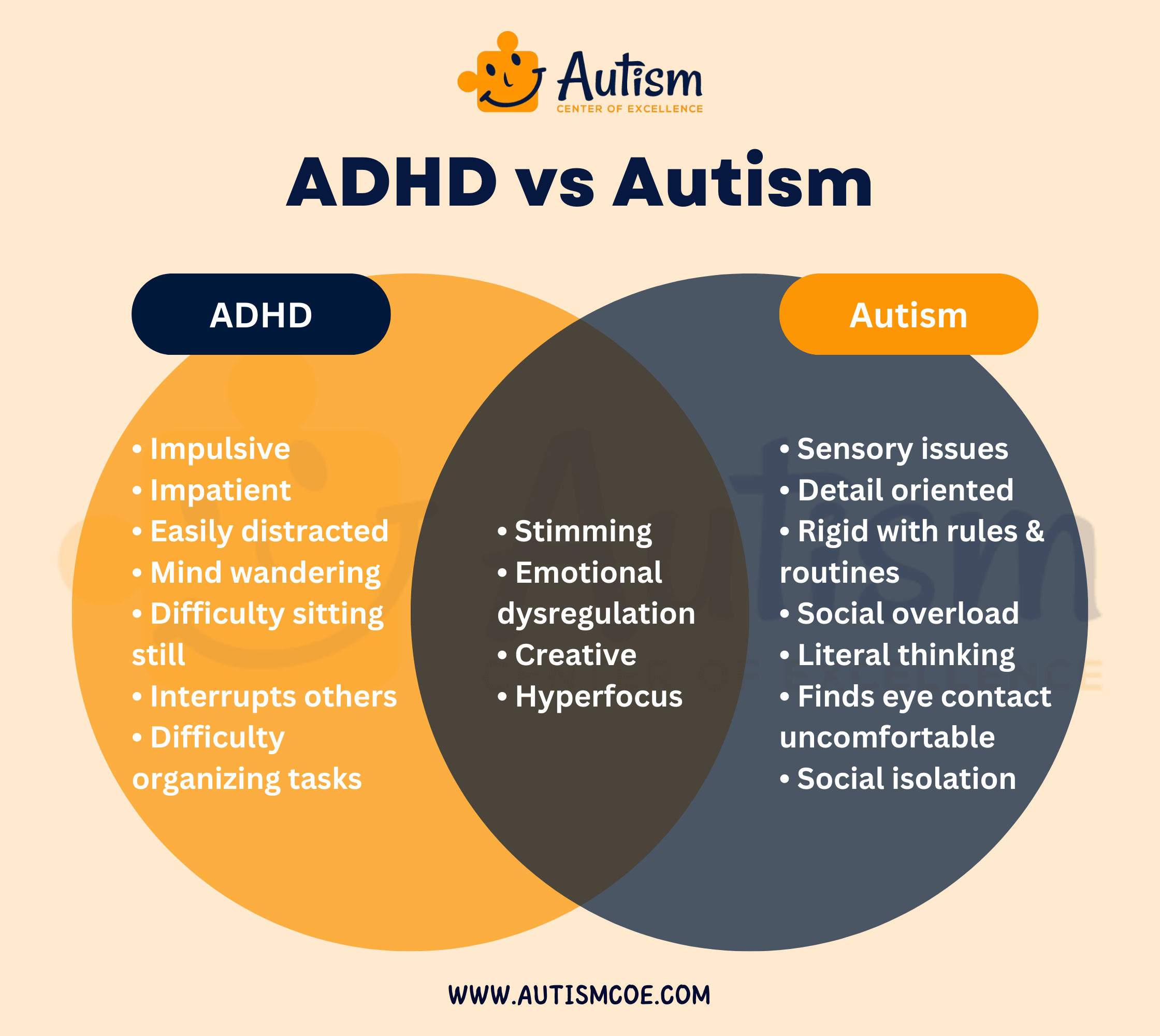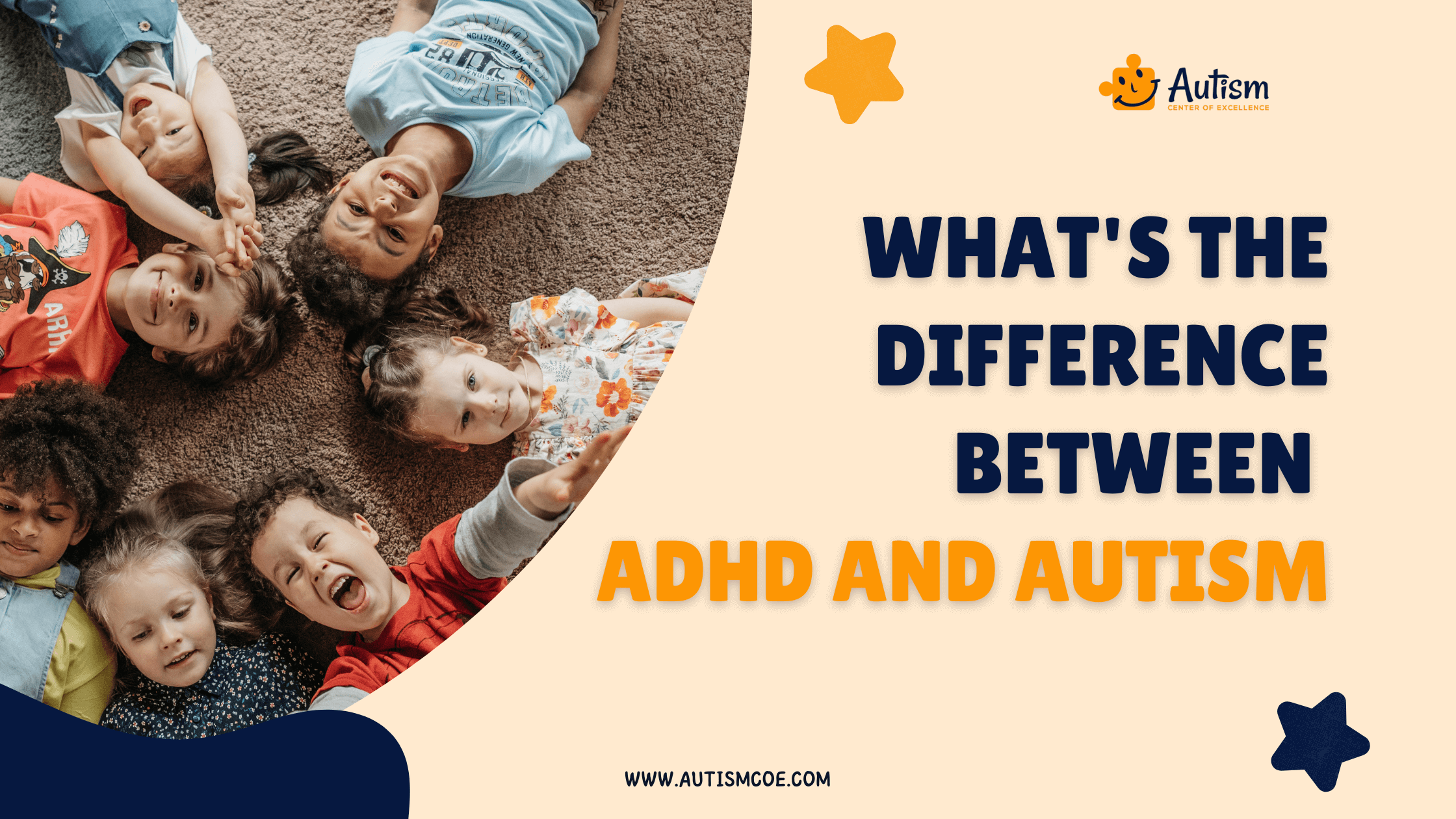ADHD and Autism are disorders that impact a person’s behavior, social relations and thought patterns because of neurodevelopmental disorders. Both are known to impact children, although their manifestations are quite different as well as the challenges encountered. These differences may not be well understood and this may lead to wrong diagnosis as well as proper treatment.
The purpose of this article is to explain the difference between ADHD and Autism based on their nature, diagnostic criteria, and approach to its management. Therefore, parents, teachers, and healthcare providers can assist individuals with either condition if they recognize the distinctions between them.
What is ADHD?
ADHD is a common neurodevelopmental disorder that affects children as well as adults, though the majority of cases are detected during childhood. ADHD is a behavior disorder that manifests in inattention, hyperactivity, and impulsivity that is considered to be beyond the child’s age.
ADHD is a disorder characterized by symptoms of inattention, hyperactivity, and impulsive behavior that lasts for at least six months. They should also have persisted for at least six months and also lead to clinically significant distress or impairment in social, academic, or occupational functioning to be diagnosed as per the DSM-5.
Some of the signs and behaviors that are most likely to be observed in children with ADHD are as follows:
Symptoms of ADHD can be categorized into two broad types: These include inattention and hyperactivity-impulsivity. Some people manifest symptoms of one type only, while others have symptoms of both types at the same time.
Inattention:
- A child has a hard time paying attention to tasks or play activities.
- Making numerous careless mistakes in schoolwork or in other tasks that are assigned to them.
- When addressed, it appears to be in a different world as it does not pay attention to what is being said to it.
- Often misplaces objects required for learning, play, work, or other activities, including toys, homework, pencils, books, or tools.
- Prone to getting easily distracted by stimuli in the surrounding environment.
- Forgetfulness in daily activities.
Hyperactivity-Impulsivity:
- Hitting objects or hands on knees, chairs, or the floor, bouncing legs, or moving the hands as well.
- Jogging or climbing in the wrong circumstances.
- Inability to perform or participate in leisure activities without much noise.
- Talking excessively.
- Being disruptive by joining other people’s conversations or interfering with their games.
- Impatience when waiting for one’s turn.
ADHD is one of the widely diagnosed neurodevelopmental disorders that affect children and young people. For instance, the CDC estimates that approximately 6. 1 million children between the ages of 2 and 17 years in the United States of America have been diagnosed with ADHD, which is approximately 9%. This was followed by 4% among the age group of 15-24 years as shown below; The statistics of children with this condition show that boys are affected more than girls, with the ratio being 3:1.
ADHD is known to be a chronic disorder that tends to continue into adulthood and it is estimated to affect 4%. This disorder affects 4% of adults aged 18-44 in the U. S. and can affect occupational, social, and academic environments. Knowledge about the nature of ADHD and the proportion of the population affected by it is the foundation for recognizing people with this disorder and providing them with assistance, as well as for comparing ADHD with Autism.
What is Autism?
Autism Spectrum Disorder (ASD), often simply referred to as autism, is a complex neurodevelopmental disorder that affects a person’s communication, behavior, and social interaction. It is a spectrum disorder, meaning that it can manifest in a wide range of ways, from mild to severe. Individuals with autism may exhibit challenges in understanding social cues, communicating effectively, engaging in repetitive behaviors, and experiencing sensory sensitivities.
┃Suggested – What is Autism Spectrum Disorder?
Join Our Weekly Newsletters!
Subscribe now to stay updated with our latest email updates.

Key Differences Between ADHD and Autism
ADHD and Autism are two different disorders that are classified as neurodevelopmental disorders that occur in children as well as in adults. It is important to distinguish between these conditions in order to make the right diagnosis and provide adequate treatment. Following are the key differences between ADHD vs autism. Additionally, understanding ADHD vs ASD can help in recognizing how individuals with ADHD struggle with focus and task completion due to distractions, while those with ASD may exhibit hyperfixation and inflexibility in their work approach.
The Difference in Symptoms Between ADHD and Autism:
ADHD
- Inattention: Inability to pay attention, making repetitive mistakes, forgetting things that happened in the recent past, and getting distracted easily.
- Hyperactivity: Fidgeting, talking, running or climbing at improper moments, and an inability to sit down when it is required.
- Impulsivity: Interrupting others, unable to wait for their turn, answering questions before the questions have been fully asked.
Autism
- Social Communication Challenges: Problems with comprehension of the verbal and non-verbal language, problems with the formation of interpersonal relationships, and the lack of interest in peer communications.
- Repetitive Behaviors: Repetitive body movements (e. g. , repetitive use of hand gestures, insistence on following precise schedules, and fixations on particular objects or ideas.
- Sensory Sensitivities: Abnormal response to things like sounds, lights, touch, or tastes.
The Difference in Causes Between ADHD and Autism:
ADHD
Even though the cause of ADHD has not been fully established, experts postulate that the condition is caused by genetic, environmental, and neurological factors. Hereditary factors are also important, as the disease has been known to be hereditary, which means that it is passed from one generation to another within a family.
Some of the environmental factors include smoking, alcohol consumption, exposure to certain toxins during pregnancy, and their effects may lead to ADHD.
Neural abnormalities that are associated with ADHD include the structure and function of the brain, especially concerning attention and impulse control. ADHD and autism have many overlapping symptoms, such as difficulties in following instructions, listening, and social interactions, which can lead to misdiagnosis. A proper ADHD diagnosis relies on detailed evaluations, including observations and interviews, to differentiate it from other conditions like autism.
Autism
It is observed that genetics play a huge role in autism and many genes have been found to be linked to the condition. It can also be inherited non-syndromal, that is, it may occur in an individual with no family history of the same.
Some of the environmental factors include; high paternal age, low birth weight, and exposure to some substances during pregnancy may also interact with genetic factors.
Disparities in structure and functioning of the brain such as connectivity and activity in specific areas are linked to autism spectrum disorders.
An autism diagnosis often involves ruling out other potential factors affecting attention and behavior before reaching a conclusion.
┃Suggested – What Caused My Child’s Autism?

The Difference in Diagnosis Between ADHD and Autism:
ADHD
- DSM-5 is used for diagnosis and involves identification of symptoms that are characteristic of inattention, hyperactivity, and impulsivity that affect functioning and development.
- A global evaluation often involves the use of interviews, questionnaires, observations, and feedback from parents, teachers or any caregivers.
- It must have started before the age of 12 and can manifest itself at school, at home or at any other place.
Autism
- Diagnosis includes an assessment of developmental history and standardized tests for social communication deficits and restricted, repetitive behaviors.
- There are various assessment instruments such as Autism Diagnostic Observation Schedule (ADOS) and Autism Diagnostic Interview-Revised (ADI-R) that help the healthcare professionals to collect the relevant information.
- It is required to be manifested from early childhood and be associated with a significant reduction in functioning.
┃Suggested – Navigating the Diagnosis Process: A Parent’s Guide to Autism
The Difference in Treatment Between ADHD and Autism:
ADHD
- The treatment is usually a combination of behavioral therapy, psycho education and medication. Methylphenidate and amphetamines are some of the most popular stimulants that are usually prescribed.
- Behavior therapy aims at the utilization of new organizational skills, application of time management and also the decrease of disruptive behaviors.
- Parent training and school based interventions are some of the significant ways used in the management of ADHD.
Autism
- There are many interventions that may be used to treat children depending on their particular needs and they may include: Applied Behavior Analysis (ABA) Therapy, Speech Therapy, Occupational Therapy.
- ABA is one of the most commonly used interventions to increase positive behaviors such as communication, social, and learning skills while decreasing the undesirable behaviors.
- Some medications can be given to control certain symptoms like anxiety, depression, hyperactivity; but there is no cure for the primary Autism symptoms.
┃Suggested – Best Autism Therapies for Your Child
Understanding the difference between ADHD and Autism helps in providing appropriate support and interventions for individuals affected by these conditions. Accurate diagnosis and personalized treatment plans are essential for improving quality of life and enhancing developmental outcomes.
Difference Between ADHD and Autism in Adults
It is crucial to distinguish between the symptoms of ADHD and ASD in adults to give the right diagnosis and treatment. While both are categorized as neurodevelopmental disorders, they feature different symptoms.
➡️ Core Symptoms: Such symptoms as inattention, excessive motor activity (not necessarily in the form of hyperactivity), and impulsivity.
➡️ Behavioral Traits:
Problems with planning and timekeeping.- Often puts off tasks and doesn’t know how to complete them.
Generally, he or she undergoes job hopping or career fluctuations due to job switch or poor performance.
➡️ Social Interaction:
- Usually has a desire for social contacts but may have difficulties in retaining these contacts due to impulsiveness or inattention.
- May stop listening in the middle of a conversation or may not seem to be listening at all.
➡️ Emotional Regulation:
It is characterized by being more likely to be emotionally driven, with distinct changes in mood.- Could have a low frustration tolerance and a low stress threshold.
➡️ Diagnosis and Treatment:
Typically, diagnosed in adulthood when people come for treatment due to job stress or marital difficulties.
Modes of intervention include the use of drugs (stimulants), behavior therapy, and teaching of organizational behavior.
➡️ Core Symptoms: Impairments in social communication and interaction as well as stereotyped and restricted patterns of behavior.
➡️ Behavioral Traits:
They experience difficulties when it comes to comprehending social signals, and other nonverbal communication.- Has a tendency to avoid changes and has a very low tolerance to change.
Has a strong preoccupation with special things like games, sports, art, or music.
➡️ Social Interaction:
May have low levels of drive for social contacts or may feel overwhelmed by the need to interact with others.- Has trouble in the interpersonal area of functioning and related to this has problems with intimacy.
Interactions may seem monotonous or self-centered, possibly because the couple is too engrossed with their individual concerns.
➡️ Sensory Sensitivities:
Increased awareness of stimuli such as sound, brightness, or touch that is beyond the normal range of tolerance.- May try to avoid some places to cope with the overload of stimuli.
➡️ Diagnosis and Treatment:
Sometimes diagnosed in adulthood when their symptoms are misinterpreted or diagnosed with other disorders.- Interventions include behavior modification, social skills training, and in some cases, occupational therapy.
It is important to know the difference between ADHD and Autism for the right support and intervention to be given to the affected adults. Proper identification of the disorders and proper management of the conditions can go a long way in improving the quality of life of the affected adults and also can address the issues related to each of the conditions.
Frequently Asked Questions & Answer
Can a Child Be Diagnosed With Both ADHD and Autism Simultaneously?
Yes, it is possible for a child to be diagnosed with both ADHD and Autism. This is known as comorbidity, and many children exhibit symptoms of both conditions.
Are There Any Overlapping Symptoms Between ADHD and Autism?
Yes, both conditions can involve difficulties with executive functioning, such as planning and organizing, and both may include impulsivity and hyperactivity, though these manifest differently.
How Do Healthcare Providers Determine Whether a Child Has ADHD, Autism, or Both?
Healthcare providers use comprehensive assessments that include clinical observations, interviews with parents and teachers, standardized tests, and developmental histories to make accurate diagnoses. They differentiate based on the specific symptom patterns and their impact on the child’s daily life.
How Do the Diagnostic Criteria for ADHD and Autism Differ?
ADHD is diagnosed based on persistent patterns of inattention and/or hyperactivity-impulsivity that interfere with functioning or development. Autism is diagnosed based on persistent deficits in social communication and social interaction, along with restricted, repetitive patterns of behavior, interests, or activities.
How Do Treatment Approaches Vary for ADHD Compared to Autism?
ADHD treatment often includes medication (such as stimulants), behavioral therapy, and educational support. Autism treatment focuses on behavioral interventions, speech and occupational therapies, and specialized educational programs.
Conclusion
Understanding the difference between ADHD and Autism is vital for an accurate diagnosis and effective treatment. While both conditions can impact similar areas of life, their symptoms, diagnostic processes, and treatments differ significantly. If you suspect you or your child may have ADHD or Autism, it’s essential to consult a healthcare provider for a professional evaluation and guidance. Autism Center of Excellence can assist by providing expert assessments to accurately diagnose these conditions, offering tailored intervention strategies, and delivering comprehensive support through behavioral therapy, parent training, and educational resources, ensuring individuals receive the appropriate care and support they need. Additionally, AutismCOE offers ABA Therapy, Autism Early Intervention Program, Autism School Readiness Program, Speech Therapy, and Occupational Therapy services for children aged 2 – 14 years in-home as well as in center-based environments. Understanding ADHD vs autism is crucial for developing effective management strategies.
Please Note: The content of this blog is for informational purposes only and should not be considered a substitute for professional medical advice, diagnosis, or treatment. Consult a qualified health care professional for personalized guidance tailored to your specific situation.

Bhavika Bhasin
Bhavika Bhasin is the Research and Marketing officer at AutismCOE. She works with children and adults with ASD. Her clinical research includes evaluating various available autism screening and diagnosis methods and their efficacy. She is currently developing a novel screening exam that is indicated to be more accurate than the existing available exams. She is also writes articles papers for various publications.


